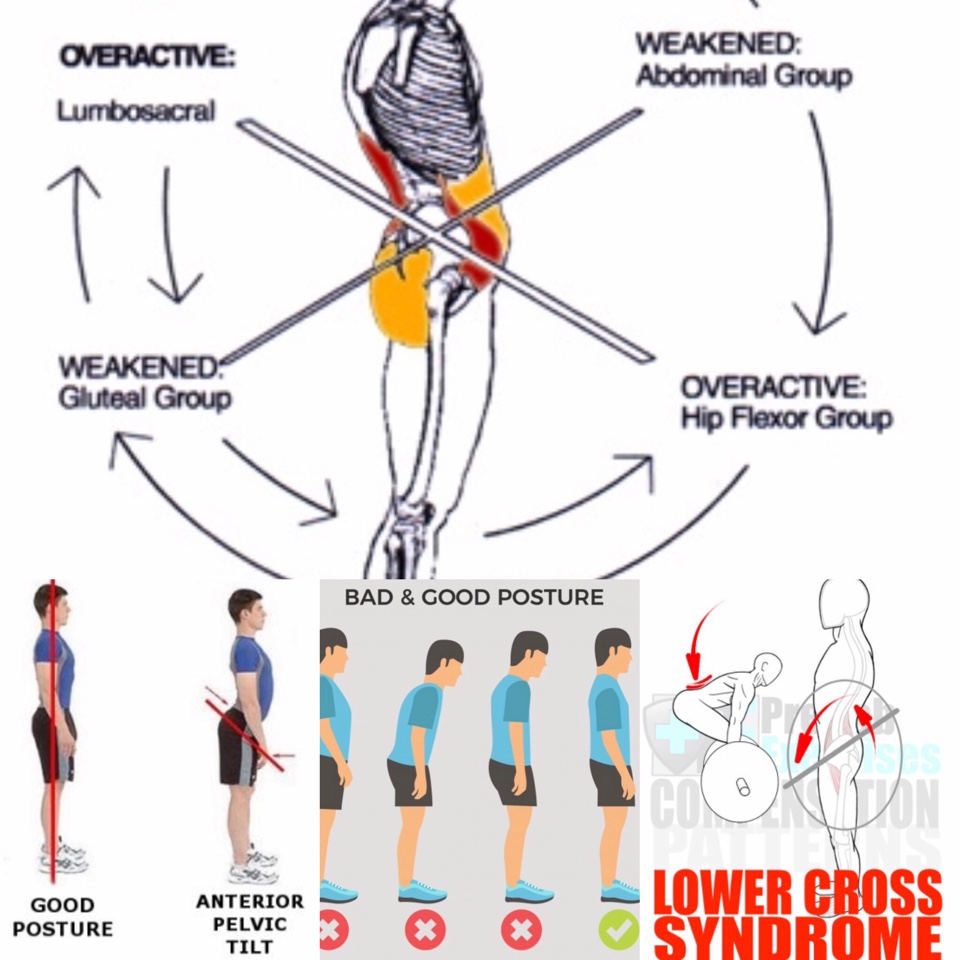Lower Cross Syndrome

The lower crossed syndrome (LCS) is the result of muscle strength imbalances in the lower segment. These imbalances can occur when muscles are constantly shortened or lengthened in relation to each other. The lower crossed syndrome is characterized by specific patterns of muscle weakness and tightness that cross between the dorsal and the ventral sides of the body. In LCS there is overactivity and hence tightness of hip flexors and lumbar extensors. Along with this there is underactivity and weakness of the deep abdominal muscles on the ventral side and of the gluteus maximus and medius on the dorsal side. The hamstrings are frequently found to be tight in this syndrome as well. This imbalance results in an anterior tilt of the pelvis, increased flexion of the hips, and a compensatory hyperlordosis in the lumbar spine.
Clinically Relevant Anatomy
The pelvic crossed syndrome involves weakness of the trunk muscles; Rectus abdominus, Obliques internus abdominis, Obliques externus abdominis and transversus abdominis; alongwith the weakness of the gluteal muscles: Gluteus maximus, Gluteus medius and Gluteus minimus. These muscles are inhibited and substituted by activation of the superficial muscles.
There is co-existing over activity and tightness of the thoracolumbar extensors: Erector spinae, Multifidus, Quadratus lumborum and Lattisimus dorsi; and that of the hip flexors: Iliopsoas and Tensor fasciae latae.
The hamstrings compensate for anterior pelvic tilt or an inhibited gluteus maximus.
Why and when does lower-crossed syndrome happen?
There are several factors involved in the development of lower-crossed syndrome, one of those is thought to be a previous injury to the joints, ligaments or muscles in the low back, pelvis or hip that doesn’t resolve completely and leaves certain muscles tight and short. This shortening and tightening of the muscles can also occur from repetitive activities or with poor posture, in particular poor core abdominal muscles often leave the lower back and pelvis less supported and more likely to develop muscular imbalances. Once a group of muscles have become tight and short, the relative opposite muscle groups become weakened and as a result the previous mentioned tight muscles tighten further. This starts a negative feedback cycle that if undisturbed accentuates the muscular imbalance.
What treatments are available for lower-crossed syndrome?
Short term treatment will focus on restoring the mobility of your joints through joint manipulation and relaxing the overly tight muscles with massage.Treatment alone will not be enough to reverse the muscular imbalance therefore your therapist will also prescribe you with exercises. Specifically mobility stretches for the tight muscles in your lower back and thighs with more specific corrective strengthening exercises for the weak gluteal and abdominal muscle groups.
Once you have recovered it is important to prevent any muscular imbalance from developing again. If the tension has built up from poor posture or weakness then it is extremely important that you look at your office chair and desk layout as well as maintaining your prescribed exercises. Pilates or Yoga are very good at strengthening your core and improving your posture and treatments.
How Massage Therapy can help people who suffer with Lower Cross Syndrome?
The benefits of Massage Therapy are:
- decrease of muscle tone
- decrease pain
- improve ROM on the lower back,SI and Hip joint
- decrease/eliminate trigger points
- strenghting weak,long and inhibit muscles
- lenghting short and tight muscles






